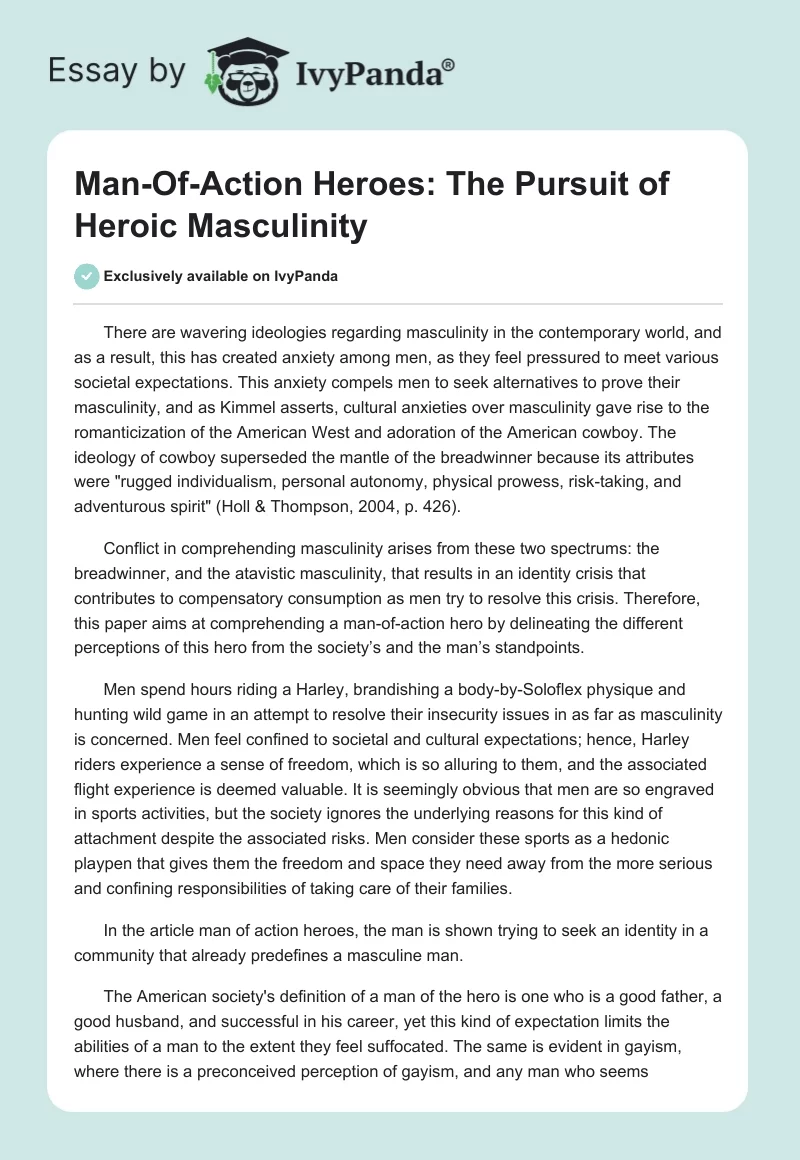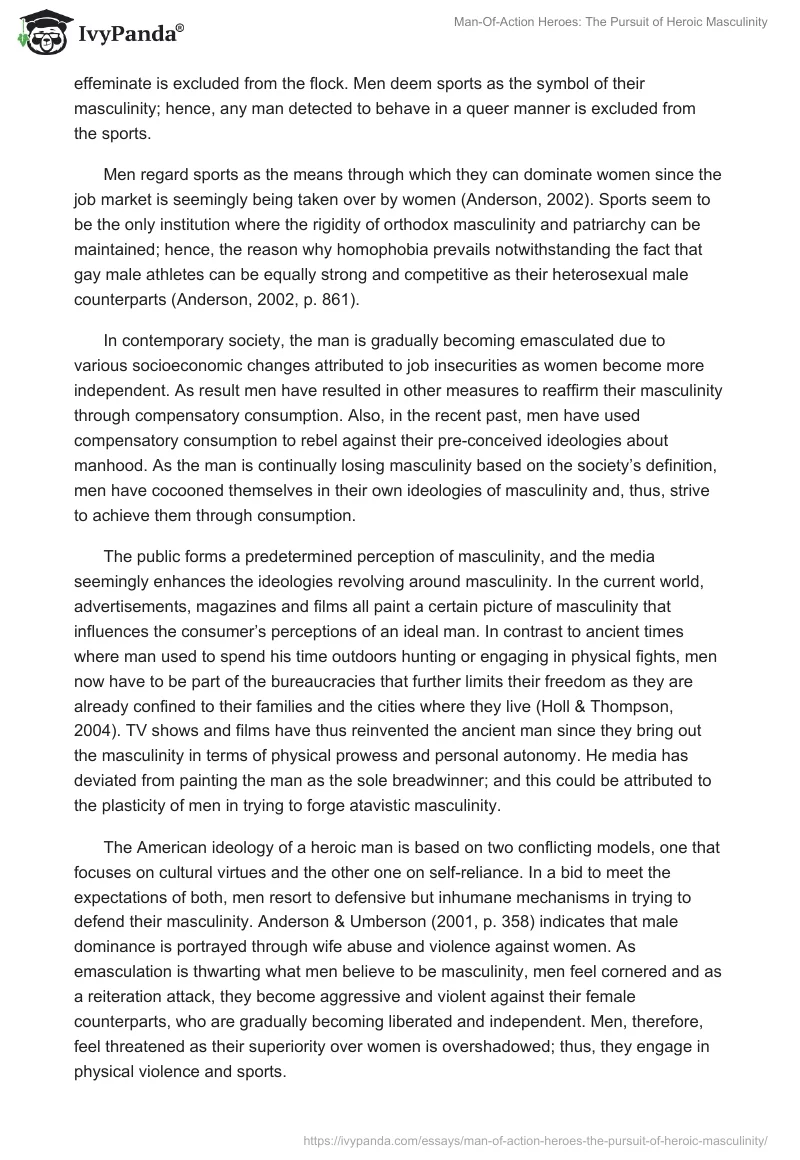There are wavering ideologies regarding masculinity in the contemporary world, and as a result, this has created anxiety among men, as they feel pressured to meet various societal expectations. This anxiety compels men to seek alternatives to prove their masculinity, and as Kimmel asserts, cultural anxieties over masculinity gave rise to the romanticization of the American West and adoration of the American cowboy. The ideology of cowboy superseded the mantle of the breadwinner because its attributes were “rugged individualism, personal autonomy, physical prowess, risk-taking, and adventurous spirit” (Holl & Thompson, 2004, p. 426).
Conflict in comprehending masculinity arises from these two spectrums: the breadwinner, and the atavistic masculinity, that results in an identity crisis that contributes to compensatory consumption as men try to resolve this crisis. Therefore, this paper aims at comprehending a man-of-action hero by delineating the different perceptions of this hero from the society’s and the man’s standpoints.
Men spend hours riding a Harley, brandishing a body-by-Soloflex physique and hunting wild game in an attempt to resolve their insecurity issues in as far as masculinity is concerned. Men feel confined to societal and cultural expectations; hence, Harley riders experience a sense of freedom, which is so alluring to them, and the associated flight experience is deemed valuable. It is seemingly obvious that men are so engraved in sports activities, but the society ignores the underlying reasons for this kind of attachment despite the associated risks. Men consider these sports as a hedonic playpen that gives them the freedom and space they need away from the more serious and confining responsibilities of taking care of their families.
In the article man of action heroes, the man is shown trying to seek an identity in a community that already predefines a masculine man.
The American society’s definition of a man of the hero is one who is a good father, a good husband, and successful in his career, yet this kind of expectation limits the abilities of a man to the extent they feel suffocated. The same is evident in gayism, where there is a preconceived perception of gayism, and any man who seems effeminate is excluded from the flock. Men deem sports as the symbol of their masculinity; hence, any man detected to behave in a queer manner is excluded from the sports.
Men regard sports as the means through which they can dominate women since the job market is seemingly being taken over by women (Anderson, 2002). Sports seem to be the only institution where the rigidity of orthodox masculinity and patriarchy can be maintained; hence, the reason why homophobia prevails notwithstanding the fact that gay male athletes can be equally strong and competitive as their heterosexual male counterparts (Anderson, 2002, p. 861).
In contemporary society, the man is gradually becoming emasculated due to various socioeconomic changes attributed to job insecurities as women become more independent. As result men have resulted in other measures to reaffirm their masculinity through compensatory consumption. Also, in the recent past, men have used compensatory consumption to rebel against their pre-conceived ideologies about manhood. As the man is continually losing masculinity based on the society’s definition, men have cocooned themselves in their own ideologies of masculinity and, thus, strive to achieve them through consumption.
The public forms a predetermined perception of masculinity, and the media seemingly enhances the ideologies revolving around masculinity. In the current world, advertisements, magazines and films all paint a certain picture of masculinity that influences the consumer’s perceptions of an ideal man. In contrast to ancient times where man used to spend his time outdoors hunting or engaging in physical fights, men now have to be part of the bureaucracies that further limits their freedom as they are already confined to their families and the cities where they live (Holl & Thompson, 2004). TV shows and films have thus reinvented the ancient man since they bring out the masculinity in terms of physical prowess and personal autonomy. He media has deviated from painting the man as the sole breadwinner; and this could be attributed to the plasticity of men in trying to forge atavistic masculinity.
The American ideology of a heroic man is based on two conflicting models, one that focuses on cultural virtues and the other one on self-reliance. In a bid to meet the expectations of both, men resort to defensive but inhumane mechanisms in trying to defend their masculinity. Anderson & Umberson (2001, p. 358) indicates that male dominance is portrayed through wife abuse and violence against women. As emasculation is thwarting what men believe to be masculinity, men feel cornered and as a reiteration attack, they become aggressive and violent against their female counterparts, who are gradually becoming liberated and independent. Men, therefore, feel threatened as their superiority over women is overshadowed; thus, they engage in physical violence and sports.
The society had failed terribly in trying to define masculine and what is expected of a man. The result has been an identity crisis that has resulted in negative alternative in an attempt to resolve this crisis. Mena engage in compensatory consumption, and are aggressive and violent as they try to defend their borders.
References
Anderson, E. (2002). Openly gay athletes: contesting hegemonic masculinity in a homophobic environment. Gender and Society, 16(6), 860-877. Web.
Anderson, K. L., & Umberson, D. (2001). Gendering violence: masculinity and power in men’s accounts of domestic violence. Gender and Society, 15(3), 358-380. Web.
Holl, D. B., & Thompson, C. J. (2004). Man-of-action heroes: the pursuit of heroic masculinity in everyday consumption. Journal of Consumer Research, 31(2), 425-440. Web.


